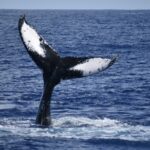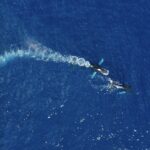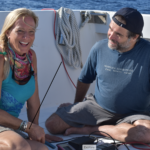On March 24th, 2022, we spent our first day on Challenger Bank in Bermuda! We collected whale photo ID’s, sloughed skin samples for DNA, drone footage displaying behavior of a competitive group of 5 humpbacks and a perfect 2022 humpback song from beginning to end.
THE SOUND OF SCIENCE
This is part of a marine acoustic study that focuses on Bermuda, its coral reefs, seamounts and surrounding Sargasso Sea as a field station and platform for passive acoustic monitoring. This addresses critical data gaps and knowledge to improve conservation and management of Bermuda’s marine systems.
This study investigates:
- Cetaceans (whales & dolphins)
- Critical habitats
- Current and proposed Marine Protected Areas (MPA’s)
- Fisheries
- Possible threats associated with anthropogenic noise
- Protected species
- Reefs
Our initial focus is to record whale vocalizations in Bermuda’s waters where humpback whale song was first “discovered” in the 1950’s and 1960’s. Our research will produce updated humpback whale occurrence and song dynamics in Bermudian waters. We will compare the behavior and ecology of humpback whales in the North Atlantic (Northern Hemisphere) to the South Pacific (Southern Hemisphere) and eventually on a global level. Project co-founder Nan Hauser has twenty-three years of whale song collected in the Cook Islands (South Pacific) to use for comparison. www.whaleresearch.org. Our collaborators include scientists involved in the original Bermuda whale recordings.
By comparing newly collected data with historical records, we can observe changing patterns and how marine life may be impacted by climate change.
Objectives:
- Build local capacity for ongoing participation in this project
- Conserve migratory marine mammal species & reef associated communities
- Document effects on mating & birthing
- Engage the Bermudian community to focus on marine biodiversity in their own backyard
- Enhance established methods for recording the sounds
- Ensure long-term management of biodiversity
- Establish a baseline dataset as the start of a longer-term time-series
- Identify individual whales
- Leverage and continue to develop latest technologies
- Monitor prey movements & abundance
- Observe changes in migratory corridors & pathways
- Record shifts in migratory patterns
- Use AI “Artificial Intelligence” for acoustic, image and biological sample analysis










